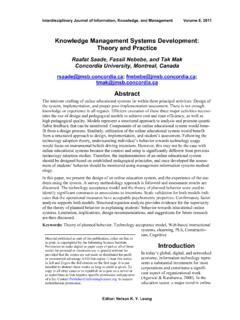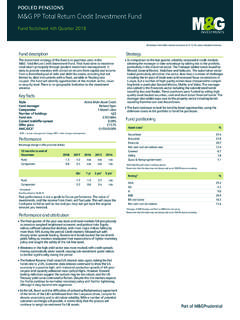Transcription of A Return on Investment as a Metric for Evaluating ...
1 Interdisciplinary Journal of information , Knowledge, and Management Volume 6, 2011 A Return on Investment as a Metric for Evaluating information Systems: taxonomy and Application Alexei Botchkarev Ministry of Health and Long-Term Care & Ryerson University, Toronto, Ontario, Canada Peter Andru Ministry of Health and Long-Term Care, Toronto, Ontario, Canada Abstract Return on Investment (ROI) is one of the most popular performance measurement and evaluation metrics used in business analysis. ROI analysis (when applied correctly) is a powerful tool for Evaluating existing information systems and making informed decisions on software acquisitions and other projects. Decades ago, ROI was conceived as a financial term and defined as a concept based on a rigorous and quantifiable analysis of financial returns and costs. At present, ROI has been widely recognized and accepted in business and financial management in the private and public sectors.
2 Wide proliferation of the ROI method, though, has lead to the situation today where ROI is often experienced as a non-rigorous, amorphous bundle of mixed approaches, prone to the risks of inaccuracy and biased judgement. The main contribution of this study is in presenting a systematic view of ROI by identifying its key attributes and classifying ROI types by these attributes. ROI taxonomy has been developed and discussed, including traditional ROI extensions, virtualizations, and imitations. All ROI types are described through simple real life examples and business cases. Inherent limitations of ROI have been identified and advice is provided to keep ROI-based recommendations useful and meaningful. The paper is intended for researchers in information systems, technology solutions, and business management, and also for information specialists, project managers, program managers, technol-ogy directors, and information systems evaluators.
3 Keywords: Return on Investment , ROI, evaluation, limitations, taxonomy , information system , performance measure, business value. Material published as part of this publication, either on-line or in print, is copyrighted by the Informing Science Institute. Permission to make digital or paper copy of part or all of these works for personal or classroom use is granted without fee provided that the copies are not made or distributed for profit or commercial advantage AND that copies 1) bear this notice in full and 2) give the full citation on the first page. It is per-missible to abstract these works so long as credit is given. To copy in all other cases or to republish or to post on a server or to redistribute to lists requires specific permission and payment of a fee. Contact to request redistribution permission. Introduction Public attention to ROI has a clear de-pendency on the state of the economy.
4 Rough times bring about tougher com-petition of projects for available dollars and spur the interest of academics and practitioners in evaluation methods, and ROI is a significant tool. Editor: Raymond Chiong A Return on Investment as a Metric for Evaluating information Systems A renewed focus on ROI can be observed today, including using ROI as a buzzword to confound understanding rather than clarify meaning. A Google search brings back millions of hits which mention ROI. New pages and updates appear at a staggering speed of increase of thousands every 24 hours. An even more specific Google search for an ROI calculator shows over several hun-dred thousand pages. The number grows several times every year. The abbreviation ROI is ar-guably one of the most frequently used business abbreviations, now often used without spelling it out. So, while the term is popular, there are completely different views concerning its use.
5 One view is that ROI is the most popular Metric to use when comparing the attractive-ness of one information technology (IT) Investment to another. ROI is a key Metric used by CIOs to help quantify the potential success of an IT or business project ( Return on Investment , ). The other view is to forget ROI. The best, most innovative IT improvements have no ROI. There was no decent ROI on installing the first Wang word processor in the 1970s or the first PC to run VisiCalc in the 1980s or the first Linux server for corporate Web sites in the 1990s.. If we let the ROI Wormtongues rule the day, this decade will never see an analogue to the technological achievements of past decades..wisdom can't be re-duced to an ROI calculation (Hall, 2003). While those are two extreme views on the use of ROI, there are dozens of views somewhere in between them. This diversity of opinion is what stimulated this study to review the current state of the issue and help provide greater understanding of ROI and its application.
6 What is ROI? According to the Investopedia, ROI is a performance measure used to evaluate the efficiency of an Investment or to compare the efficiency of a number of different investments. To calculate ROI, the benefit ( Return ) of an Investment is divided by the cost of the Investment ; the result is expressed as a percentage or a ratio ( Return on Investment - ROI, 2011.). The Return on Investment formula: There are many other ROI definitions in the literature ( , Rate of Return , ; Goetzel, ). Each definition focuses on certain ROI aspects. Such definitions reflect the fact that approaches to ROI and even ROI concepts vary from company to company and from practitioner to practitio-ner; most likely every consultant has a particular variation. Despite the diversity of the defini-tions, the primary notion is the same: ROI is a fraction, the numerator of which is net gain (re-turn, profit, benefit) earned as a result of the project (activity, system operations), while the de-nominator is the cost ( Investment ) spent to achieve the result.
7 However, in some publications, the numerator in the ROI formula is equal to the project gain (not gain minus cost) (Mogollon & Raisinghani, 2003). Usually, this Metric is called benefit-cost ratio. It should be noted that in such cases the results of the calculations have a different meaning. For example, ROI of 100% means that the amount of the Return equals the amount of the money invested no additional money was gained. A more common sense use of the above formula, one hundred percent ROI means not only the Return of the money invested but also gaining the same amount as profit. 246 Botchkarev & Andru The definition from Investopedia treats ROI as a measure / Metric / ratio / number. In some cases, Return on Investment is understood as a method or approach ROI analysis . In this mean-ing, ROI or ROI Analysis includes not only an ROI ratio but also several other financial measures ( , internal rate of Return - IRR, net present value - NPV, payback period, etc.)
8 , which are collectively called ROI (Mogollon & Raisinghani, 2003). Further, within this approach some articles may read, ROI is three months That would mean that ROI analysis has been per-formed and a payback period indicator was used, which was calculated to be 3 months. In specific situations, ROI variations can be used: Return on invested capital, Return on total assets, Return on equity, Return on net worth (Andolsen, 2004). Finally, Return on Investment may be understood as any kind (financial or non-financial) of Return / effect / result or general business impact/value. This paper is focused on ROI as an individual measure. Other measures of the ROI analysis are referred to as ROI-related measures and are not included in the primary scope of work. The purpose of ROI varies and includes: 1. Providing a rationale for future investments and acquisition decisions: Project prioritization/ justification.
9 Facilitating informed choices about which projects to pursue (which solutions to imple-ment). 2. Evaluating existing systems. Project post-implementation assessment. Facilitating informed decisions within the process of Evaluating existing pro-jects/solutions. 3. Performance management of the business units and evaluation of the individual managers in decentralized companies: Often called the Du Pont method by the name of the company which first implemented it and considered a default standard in the 1960-70s. The method has been analyzed in John Dearden s article published in the Harvard Business Review (Dearden, 1969). The title of the article is very revealing: The case against ROI control. The article indicates a wide spread of the ROI method and frequent incorrect use of the measure. It is stated that ROI oversimplifies a very complex decision-making process.
10 This type of ROI use is out of scope for this paper. Some authors look at ROI evaluations even broader: as a method of persuasive communication to senior management, a process of getting everybody s attention to the financial aspects of the decisions and stimulating a rigid financial analysis. In this case, actually calculated ROI numbers are of less importance compared to the processes of gathering/analyzing cost and benefit data (Kalvar, 2003). ROI popularity is due to many objective and subjective reasons. Objective Reasons for ROI Popularity: Anecdotal evidence of successful use. Easy to understand and straightforward. Easy to compute. Encourages prudent detailed financial analysis. 247 A Return on Investment as a Metric for Evaluating information Systems Encourages cost efficiency and focuses on one of the main corporate metrics profit-ability. Being based on the accounting records, provides objective outputs.













